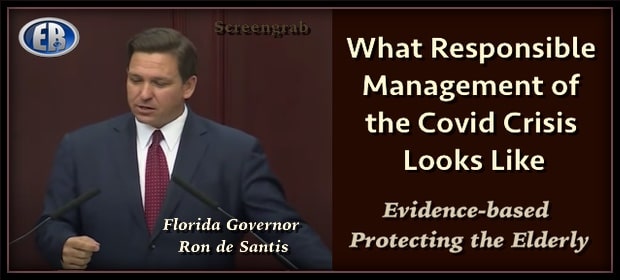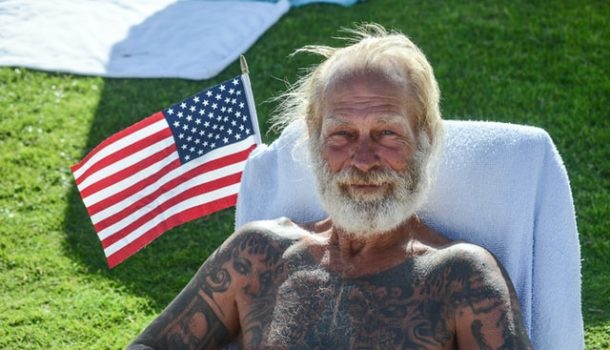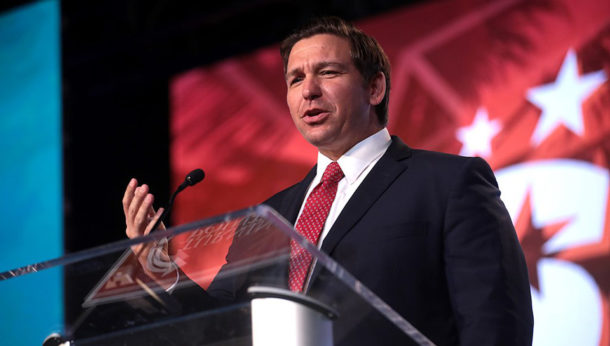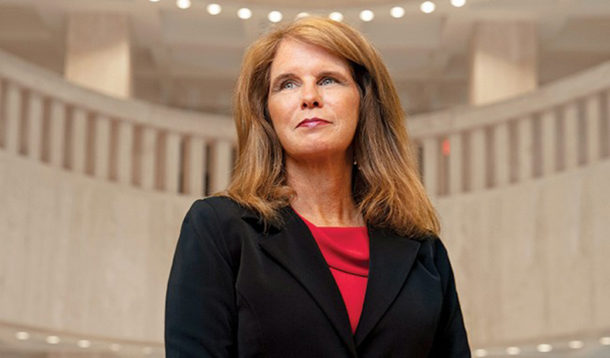
Inside Florida Health’s ‘Focused Protection’ Covid Plan for Elderly Residents
21WIRE
One of the biggest misconceptions and fake news talking points about how Florida and other states, including South Dakota, somehow ‘defied science’ to keep their states open and without the need for strict, unconstitutional lockdown rules screams ‘Coronatarian’ (or ‘Covidiot’) conspiracy theory – claiming that Governors like Ron DeSantis unilaterally made these public health policy decisions in a vacuum.
We now know, from looking at the evidence and hearing from the rare, intellectually sober health officials in these states, that the reality is something far different.

Florida seniors, like this man celebrating the 4th of July holiday, can enjoy a free and healthy lifestyle in the Sunshine State.
Florida has protected the dignity and well-being of its oldest residents, all while taking constant incoming from the medical media complex, and yet has prospered as a ‘free state’ in the age of Covid.
In his most recent column for the Irish media outlet Gript, writer Thade Andy take us inside Florida’s state health agency – its leadership, and its successful triage strategy for ‘shielding’ elderly Floridians from infections across the state.
Gript reports…
How is it that the state of Florida, a state run by a Republican Governor who has rejected wholesale the lockdown wisdom, has had such success in reducing Covid numbers? How is it that the same state, known as the retirement home of America, has been one of the most successful states in America in protecting its elderly citizens?
How did they do all this while Governor, Ron DeSantis, kept the state open for business despite the protests of the zero-covid type Coronatarians.
Florida has a population of over 22 million people, has counties with dense urban populations, and has a senior population (over 65 years of age) of 4.4 million, with 3 million over 70. It has roughly 4,000 elderly care homes and roughly 155,000 residents of these homes.
Florida has suffered 1,616 deaths per million of population, placing it in the bottom (better) half of states in the U.S. for this statistic. The average is 1,765.
Approximately 1 in 5 of its residents are in the high risk category for Covid, so how did Florida stay open and not have a catastrophic level of deaths amongst its elderly?
The answer is in the dedication to evidence-based policy that the leaders of Florida determined to pursue from the very outset of the Covid pandemic.
As it materialised that Covid was a global pandemic, the Governor of Florida, Ron DeSantis, looked at what the death tolls were telling us. When early data became available from South Korea, DeSantis said they looked carefully at the fine details of who was dying and who was getting sick.
That analysis (which any policy maker anywhere could have made, as they had access to the same information) showed that this was an illness that almost exclusively struck hard at the elderly.
As early as May 2020, DeSantis was able to report on how his state had assessed and responded to this risk:
“I just thought it was so dramatic, the extent to which this was concentrated in the older age groups. I think the first real fresh set of South Korea numbers I looked at, I think it had no fatalities under 30, and then 80 percent of them were 70 and above or something like that. It was really, really dramatic.”

Governor of Florida, Ron DeSantis
Italy also provided early data, but while the rest of the world took Italy as a dire precursor to their own future, DeSantis’s team did a granular study of the statistics. Again they learned that the elderly (with a median age of 82) took the brunt of casualties, but more crucially they learned that this was the main ‘at-risk’ group, and that they could successfully focus protection on this vulnerable group.
So while other leaders were spreading resources too thin, in Florida the number one priority was elderly care homes and retirement villages.
PPE resources were put first into care homes. This was where the vulnerable population was so it was prioritised above hospitals. As De Santis rightly recognised, “If I can send PPE to the nursing homes, and they can prevent an outbreak there, that’s going to do more to lower the burden on hospitals”.
He implemented a state-wide system of active management to ensure the strictest guidelines were implemented in care homes. This required all staff and any worker that entered to be screened for COVID symptoms including temperature checks. Anybody who exhibited any symptoms would just simply not be allowed to go in.
In the hospitals, care was taken not to discharge the elderly back into care homes prematurely. De Santis’s team were insistent that they be kept in hospital until all risk of Covid contagion had passed.
This might seem like an obvious call, but remember that all over the world, Covid contagious patients were being returned to care homes because people were panicking that the hospitals would be overrun. That reactionary decision proved disastrously fatal for elderly care residents all over the world, but not so in Florida.
Pushing these policies on a day to day basis was Mary Mayhew, secretary of Florida’s Agency for Healthcare Administration. Her job included daily calls with the hospitals to manage this situation as she was acutely aware of the pressure to release elderly Covid patients back to the care homes.

Mary Mayhew, secretary of Florida’s Agency for Healthcare Administration. “You don’t make good decisions if you are constantly in crisis mode”
She recounts that: “Every day on these calls, I would hear the same comments and questions around, we need to get these individuals returned back to the nursing home.”
However, and despite the feverish atmosphere pushed by the media, she says they held firm.
“We drew a hard line early on”, she said. “I said repeatedly to the hospital, to the CEOs, to the discharge planners, to the chief medical officers, ‘I understand that for 20 years it’s been ingrained, to get individuals in and out. That is not our focus today. I’m not going to send anyone back to a nursing home who has the slightest risk of being positive.’”
Having watched how the opposite of this policy played out in New York, Ireland, and other places, it’s clear that that single policy saved the lives of thousands, and possibly tens of thousands.
Severe outbreaks in care homes were prevented by isolating positive cases before they had a chance to spread. Upon hearing of a case in a nursing home, the state rapidly deployed emergency response teams to prevent cases spreading. If the home couldn’t isolate the cases, they were transferred to hospital. This way, the majority of the outbreaks that occurred in nursing homes had between just one and five infections.
That deserves repeating. Outbreaks of Covid-19 in nursing homes were tackled so quickly and so effectively that the majority of outbreaks had no more than five cases of infection.
************
Source

••••
The Liberty Beacon Project is now expanding at a near exponential rate, and for this we are grateful and excited! But we must also be practical. For 7 years we have not asked for any donations, and have built this project with our own funds as we grew. We are now experiencing ever increasing growing pains due to the large number of websites and projects we represent. So we have just installed donation buttons on our websites and ask that you consider this when you visit them. Nothing is too small. We thank you for all your support and your considerations … (TLB)
••••
Comment Policy: As a privately owned web site, we reserve the right to remove comments that contain spam, advertising, vulgarity, threats of violence, racism, or personal/abusive attacks on other users. This also applies to trolling, the use of more than one alias, or just intentional mischief. Enforcement of this policy is at the discretion of this websites administrators. Repeat offenders may be blocked or permanently banned without prior warning.
••••
Disclaimer: TLB websites contain copyrighted material the use of which has not always been specifically authorized by the copyright owner. We are making such material available to our readers under the provisions of “fair use” in an effort to advance a better understanding of political, health, economic and social issues. The material on this site is distributed without profit to those who have expressed a prior interest in receiving it for research and educational purposes. If you wish to use copyrighted material for purposes other than “fair use” you must request permission from the copyright owner.
••••
Disclaimer: The information and opinions shared are for informational purposes only including, but not limited to, text, graphics, images and other material are not intended as medical advice or instruction. Nothing mentioned is intended to be a substitute for professional medical advice, diagnosis or treatment.



